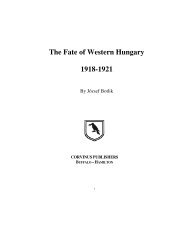The Tsangos of Romania - Corvinus Library - Hungarian History
The Tsangos of Romania - Corvinus Library - Hungarian History
The Tsangos of Romania - Corvinus Library - Hungarian History
You also want an ePaper? Increase the reach of your titles
YUMPU automatically turns print PDFs into web optimized ePapers that Google loves.
and then the person who had this vision must take food orsomething to the grave, dig a hole there and place it in for thedead.In Gaiceana, the old people were asked about when theycame to Moldavia. Some said in the time <strong>of</strong> Szent László butsome said during the Turks. This is what an old man said: "When I was in Hungary in the villages there were some peoplewho were catholics, some orthodox, some I do not know what.What kind <strong>of</strong> people are they? We are good <strong>Hungarian</strong>s. In ourvillage there are only catholic <strong>Hungarian</strong>s.BÉLA BARTÓK AND THE CSÁNGÓSBetween 1904 and 1918, Béla Bartók wandered amongthe <strong>Hungarian</strong>s collecting folksongs. He not only wanted tohave a picture <strong>of</strong> the <strong>Hungarian</strong>s inside the borders <strong>of</strong> Hungary,but also outside <strong>of</strong> it. So he made arrangements to go toMoldavia in 1913, but had to postpone his trip to August 1914.But as much as Béla Bartók was looking forward to this meetingwith the Csángós, he could not accomplish it because <strong>of</strong> theoutbreak <strong>of</strong> the First World War. In the preface <strong>of</strong> his book, AMagyar Népdal published in 1924, he called attention to the factthat in Moldavia there are <strong>Hungarian</strong>s whose culture, life style,music has not yet been examined. Pál Péter Domokos, onhearing this, decided to go and do this job. He first went toMoldavia as already mentioned in 1929, and collected 68folksongs and 86 lyrics which he showed to Béla Bartók in1930. So we can safely say that Batók's first meeting with theCsángós was in 1930, through Pál Péter Domokos. SándorVeres was the second to go to Moldavia. He collected 137 tuneswhich Bartók also had a chance to see. Later, in 1932,Domokos returned to Moldavia and made a tour around thewhole <strong>of</strong> Moldavia in four months. <strong>The</strong> folksongs which hecollected on his journey, were recorded and also listened to byBartók. Péter Balla, in 1933, was the next to go to Moldaviaand return still with unknown folksongs for Bartók to hear.Although Bartók never had an opportunity to go to Moldavia,through all these people bringing him materials he managed toconstruct a picture for himself about the Csángós.In 1938, two Csangó families went to Budapest whereunder the direction <strong>of</strong> Bartók they sang in the studio <strong>of</strong> the<strong>Hungarian</strong> Radio. An LP was compiled with their songs, titled
















